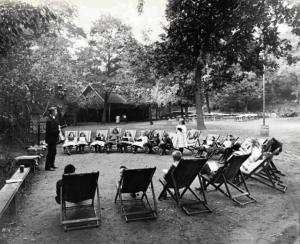Mary Ellen Chase, 1936.
I had not heard of Chase before seeing a mention of In England Now (1937) in Juliet Gardiner’s comprehensive The Thirties: An Intimate History. Despite the slightly different name and date, from the quotations Gardiner gives I think In England Now and This England are the same book, a collection of essays about England by Chase, an American novelist and academic.
Image from endpapers:

Wikipedia says she is regarded as one of the most important regional literary figures of the early twentieth century. There is a 1995 biography by one of her students, A Lantern in the Wind by Elienne Squire. There is a 1962 article about her here (PDF) and a 2003 thesis about her life and work here (PDF, 272 pages, mostly about her family background and early life, and the themes of her books, rather than her later, professional, life). I was particularly interested in the sections in the thesis about Chase’s character Mary Peters’s creation of art through rag rugs:
She became an expert in dyeing bits of wool, working hours to get the exact shade she needed. When her piecebags and closets were exhausted of old material, she bought odds and ends from factories and coloured them to suit herself. The knuckles of her fingers and the palms of her hands grew rough and calloused by hook and burlap, but she had never in her life felt more free.
(from Mary Peters, 1934).
Chase was apparently much influenced by Sarah Orne Jewett, whose The Country of the Pointed Firs I was amazed by when I read it. I have not read it since as I’m not sure how well it would stand up to re-reading.
Anyway, about This England. I must say it is a rather irascible book. Chase, spending two years in England, based in a cottage in Grantchester (not clear whether her companion, the historian Eleanor Duckett, was with her, but if so Chase wrote her out), was unhappy about many things:
The English weather and its associated travails: “chilblains … demand more resignation and humour than is the capital of most steam-heated Americans. The woollen underwear which one must wear or perish harbours and transmits its manifold vexations … this dismal monotony of discomfort … unspeakable irritation”.
No ice: “Ice simply is NOT … the English consider ice an extravagant and unnecessary commodity”.
Wasps: “There is hardly a breakfast or lunch, surely never a tea, from May to October which is not copiously attended by wasps.”
The lack of good service: The American expects “that when his trousers need pressing, they will be pressed well and quickly; that when dry cleaning is imperative, it will be perfectly accomplished in a short space of time; that when he gives his orders for immediate delivery to the grocer, the chemist, or the tailor, these men will jump to execute them. … [When this doesn’t happen] he is at first amazed and then annoyed. If he stays long enough in England … there is a chance that he may become partially converted to this incredible manner of living.”
Shops in the north of England: “miserable shops displaying through grimy, unwashed windows pink rock candy, drill overalls, tinned sardines, sticky kippers, sucking dummies for babies, garish underwear, impossible hats.”
People who visit museums and galleries on Sundays: “there are few pastimes less agreeable in London as elsewhere than Sunday visits to such places. Among the crowds who throng them on that day there is, on the one hand, too much consciousness of self-improvement, and, on the other, too little appreciation or intelligence.”
Luggage: “sundry cases of fibre or pasteboard or worn leather, baskets with lunch and bathing-costumes, umbrellas, tennis racquets, boxes and bundles of sorts. English luggage in general rarely delights the fastidious eye and never less so than when it is carrying the family clothing to the seaside.”
Having said this, there is more positive stuff. She likes the English countryside and she is even almost persuaded at times that there are good things about the weather. She feels that the northern cities with the terrible shops have more life and welcome in them than the sleepy south. She is transported about “the Yorkshire puddings which my housekeeper for two years has constructed for me [and which] rise like the turrets of some castle at sundown, crisp and golden, and with an appeal to the imagination perilously akin to that inspired by cooking across the channel”. But overall she sounds judgmental about people who are just going about their life, with their ugly luggage and hats and their attempts at self-improvement, and annoyingly patronising when she believes she can read people’s feelings (such as the woman on the ‘bus whom she decides is heart-broken about the flowers she is taking to a friend being less sophisticated than those another friend is taking).
I would like to know when parish churches stopped tolling for the dead (funeral tolling; death knell, passing bells, the latter apparently technically being hand bells rather than church bells). I know this custom best from The Nine Tailors (1934), where the ex-sexton and current bell-ringer, Hezekiah Lavender (good name), says “We got to ring her for every Christian soul dyin’ in the parish … That’s set down for us”. Chase notes that in the West Country, church “passing bells still toll for the dying and the dead, the initial strokes of one, two or three signifying whether a man, a woman or child has died”. And did they toll for all parish inhabitants or only for church members? What Hezekiah says implies everyone except possibly the odd atheist.
Follow my blog with Bloglovin




